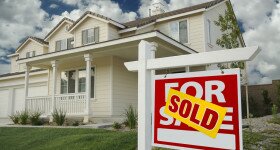About 759,000 properties regained equity in the second quarter, bringing the total number of residential mortgages that are lower than their property’s value to about 45.9 million. That equates to about 91 percent of all mortgaged properties. Borrower equity has risen year-over-year by $691 billion, according to CoreLogic’s second quarter equity report.
“For much of the country, the negative equity epidemic is lifting,” says Anand Nallathambi, CoreLogic’s CEO and president. “The biggest reason for this improvement has been the relentless rise in home prices over the past three years which reflects increasing money flows into housing and a lack of housing stock in many markets.”
CoreLogic predicts home prices to rise an additional 4.7 percent over the next year, and if that prediction holds true, 800,000 home owners could regain positive equity by July 2016. The majority of positive equity is centered on the high-end housing market. CoreLogic’s report finds that 95 percent of homes valued at more than $200,000 have equity, compared with 87 percent of homes valued at less than $200,000.
Still, the total number of mortgaged residential properties with negative equity remains elevated at 4.4 million – or 8.7 percent of all properties with a mortgage, according to CoreLogic’s report. Negative equity refers to a home owner who is “underwater,” owing more on their mortgage than their home is currently worth.
Of the more than 50 million residential properties with a mortgage, about 9 million or 17.8 percent have less than 20 percent of equity and 1.1 million – or 2.3 percent – have less than 5 percent equity.
“Borrowers who are ‘under-equitied’ may have a more difficult time refinancing their existing homes or obtaining new financing to sell and buy another home due to underwriting constraints,” CoreLogic notes. These borrowers are also more at risk of moving to negative equity if home prices fall.
Five states alone accounted for nearly 32 percent of negative equity in the United States. The states with the highest percentage of mortgaged residential properties in negative equity are Nevada (20.6%), Florida (18.5%), Arizona (15.4%), Rhode Island (13.8%), and Illinois (13.1%). By large metro area, Tampa-St. Petersburg-Clearwater, Fla., had the highest percentage of residential properties in negative equity territory at 20.2 percent, followed by Phoenix-Mesa-Scottsdale, Ariz. (15.4%), Chicago-Naperville-Arlington Heights, Ill. (15.3%), Riverside-San Bernardino-Ontario, Calif. (12.3%), and Warren-Troy Farmington Hills, Mich. (11.8%).
On the other hand, the states with the highest percentage of mortgaged residential properties in positive equity are Texas (97.9%), Alaska (97.6%), Hawaii (97.5%), Montana (97.2%), and Colorado (96.7%). Of large metro areas, Houston-The Woodlands-Sugar Land, Texas had the highest percentage of properties with positive equity at 98.1 percent, followed by Portland-Vancouver-Hillsboro, Ore./Wash. (97.8%), Dallas-Plano-Irving, Texas (97.8%), Anaheim-Santa Ana-Irvine, Calif. (97.5%) and Denver-Aurora-Lakewood, Colo. (97.5%).








Speak Your Mind